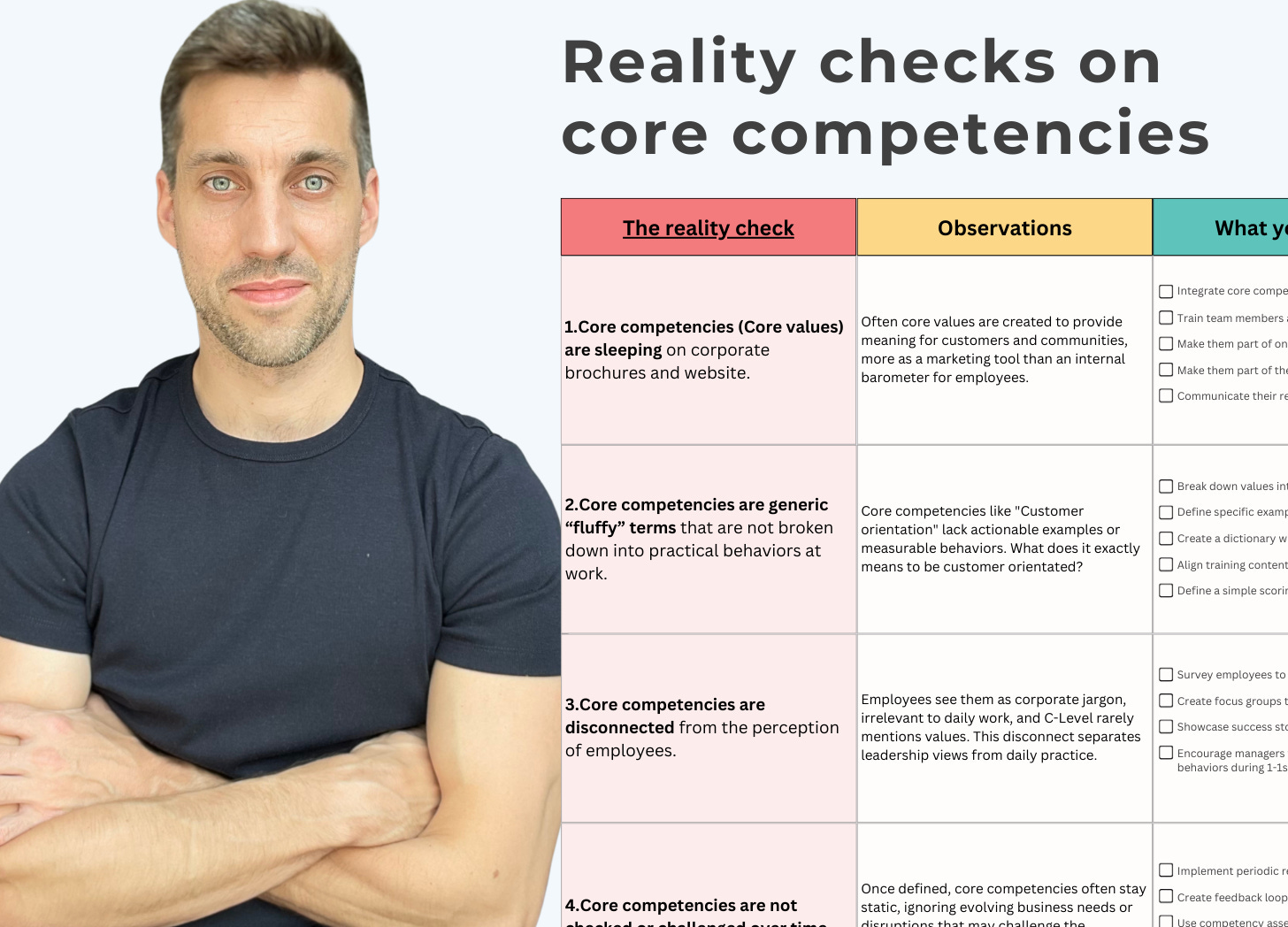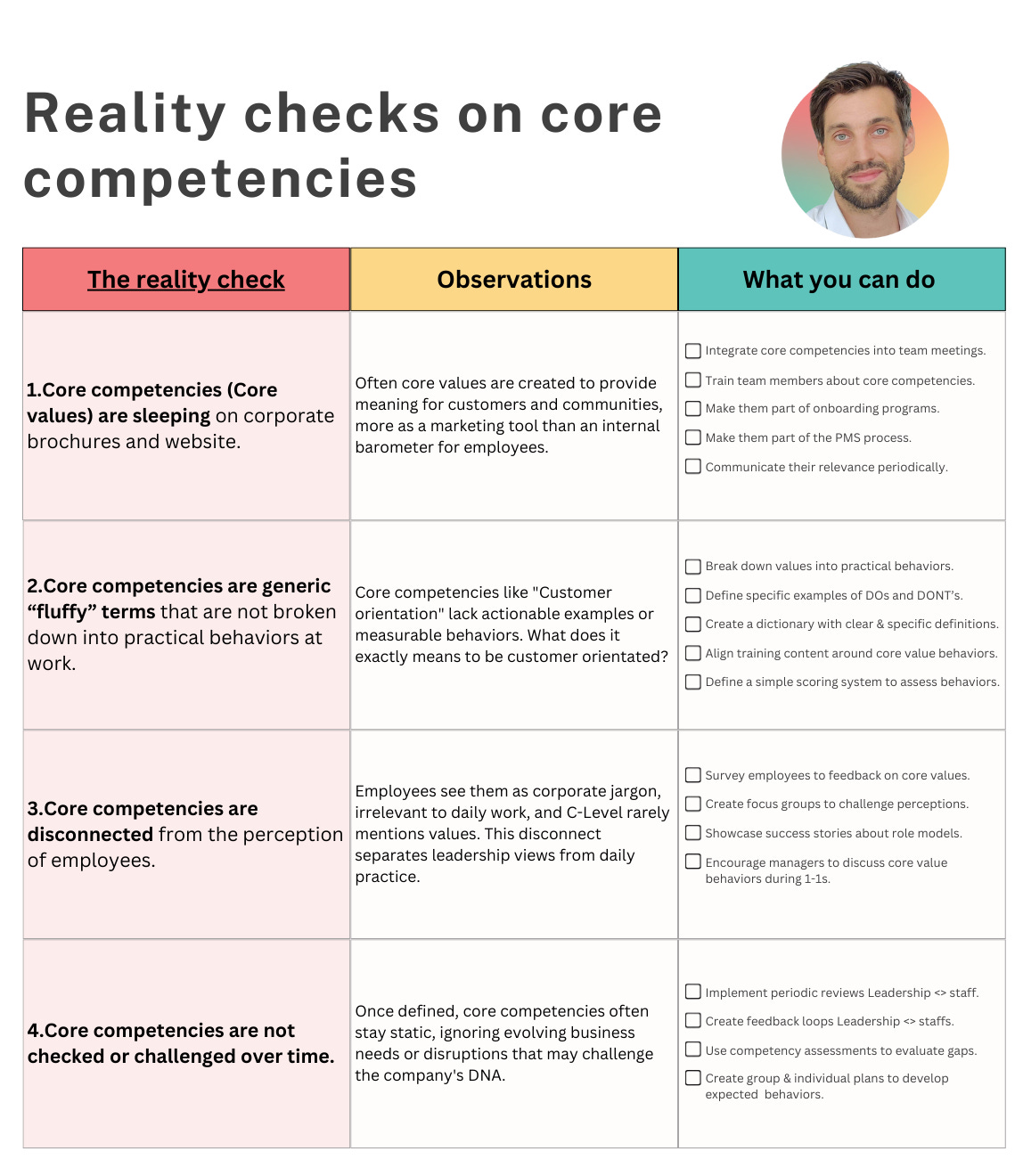Why you should give a damn about core competencies
Don't let them get lost in your company brochures and career sites.
Contrary to popular belief, the idea of core competencies is relatively new. It emerged in the 1990s as a way to connect a company’s core values with the key capabilities of its people.
But let’s be real. If you ask what are the core competencies to non HR professionals, they might probably tell you
“Oh yeah, we have core competencies—they’re listed on our corporate website and brochures. But, quite frankly, no one in the company gives a damn about them.”
This sentiment rings true for many organizations. However, for companies looking to take competency development seriously, core competencies are an excellent starting point because:
They should be embedded in your recruitment process to better evaluate “culture fit” and reduce the cost of mis-hiring.
They form the foundation for group Individual Development Plans (IDPs) after proper assessment. This approach allows the organization to identify both individual and collective strengths, fostering alignment and boosting employee engagement.
What is a Core Competency?
A core competency is what sets a company apart from its competitors. It’s a unique capability that gives a business a competitive edge.
Core Competencies Are:
Distinctive: They drive the creation of products and services that strengthen the company’s market position.
Difficult to Imitate: They are unique in their design and definition.
Aligned with Core Values: They reflect what the company stands for.
Think of a core competency as the company’s signature move—something no competitor can easily replicate.
<div class="flourish-embed flourish-hierarchy" data-src="visualisation/7650891"><script src="https://public.flourish.studio/resources/embed.js"></script><noscript><img src="https://public.flourish.studio/visualisation/7650891/thumbnail" width="100%" alt="hierarchy visualization" /></noscript></div>
The interactive image above is an example of an organization’s core competencies. The core competency is broken down with distinct skills and behavior which are unique to the organization.
⚠️ Important: Core competencies work if they are clearly defined with associated behaviors and skills.
Are Core Competencies Different from Skills?
Absolutely. Think of skills as individual tools in a toolbox—they are specific, teachable, and often come with certifications.
On the other hand, core competencies are like the blueprint for building something great with those tools. They combine skills, behaviors, and knowledge to deliver the company’s unique value to customers.
Skills might change with technology, but core competencies act as the foundation that keeps everything aligned.
How Many Core Competencies Does Your Organization Need?
Less is more. Organizations typically need no more than 4 core competencies to run effectively. In fact, having 2 well-defined competencies is often better than having too many vague ones.
Golden Rule:
Core competencies must be easy to understand for every employee. If people can’t grasp them, they won’t align their actions with them.
Think the core competency as a group. To be understandable for employees, clear behaviors must be broken down and reflect the reality of the company at work.
- 🔵 Customer orientation = Core competency
— 🟢 Customer focus = Sub- behavior
— 🟢 Accountability = Sub- behavior
— 🟢 Problem resolution = Sub- behavior
⚠️ Too often we see organizations relying on the conceptual 🔵 competency level without breaking down the core competency into clear 🟢 sub behaviors.
Why Core Competencies Matter for Organizations
Core competencies are the building blocks of strategy, growth, and sustainability. They guide big decisions, such as investments, partnerships, and outsourcing.
Core Competencies Provide Clarity:
For Leadership: They simplify strategic decision-making.
For Employees: They clarify the company’s purpose and their role in achieving it.
For HR: They align talent acquisition, performance management, and learning strategies.
Core Competencies Create Focus:
Companies with well-defined core competencies know what they do best—and they focus on doing those things exceptionally well. For everything else, they consider outsourcing.
Imagine core competencies as the North Star guiding every aspect of the business—from product design to customer service.
The Challenges of Implementing Core Competencies
1. Staying Relevant:
Core competencies must evolve with the company’s mission and market changes. What worked yesterday might not work tomorrow.
2. Employee Buy-In:
If employees don’t understand the core competencies—or if they’re poorly defined—they’ll seem like abstract concepts with no real connection to day-to-day work.
Key Takeaway: Clear communication and ongoing reinforcement are essential for core competencies to become part of the company culture.
6 Steps to Build Core Competencies in Your Organization
1. Start with Your Company Values
Core competencies must align with your value proposition—what your company promises to deliver.
Involve leadership, HR, and external consultants to identify what makes your organization unique.
Look at your assets, patents, brand equity, and talent pool to spot recurring strengths.
2. Define Expected Skills and Behaviors
Clarity is everything. Define each competency with specific skills and behaviors employees can understand and act on.
Avoid overly complex frameworks with too many levels or definitions.
Keep it clear, actionable, and easy to reference.
Pro Tip: Huneety offers pre-built taxonomies that save time and ensure clarity.
3. Choose a Simple Assessment Scale
Use a 1 to 5 scale to measure competency levels.
The scale should fit naturally into your performance management system.
Huneety can help customize your scale to align with your goals.
4. Validate with Staff Before Rolling Out
Before introducing core competencies company-wide:
Validate them with staff representatives.
Communicate their purpose clearly.
Integrate them into job descriptions, training plans, and recruitment processes.
5. Perform Assessments with Quality Feedback
Assessments are not just about scores—they’re about useful feedback.
Feedback should be fact-based and actionable.
Managers play a crucial role here. Poor feedback can derail the entire process.
Huneety’s platform ensures managers provide meaningful feedback through structured forms.
6. Monitor and Refine Over Time
Core competencies are not static. They need regular monitoring and updates.
Link them to Individual Development Plans (IDPs) using frameworks like 70-20-10.
Blend on-the-job learning, social learning, and formal training for best results.
In Conclusion
Core competencies aren’t just HR buzzwords—they are the DNA of organizational success. When defined and implemented well, they guide strategy, improve employee clarity, and ensure long-term competitiveness.
But they require clarity, consistency, and regular updates to remain effective.



